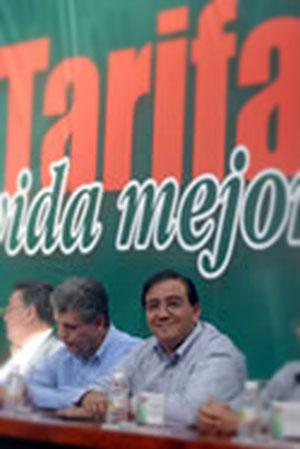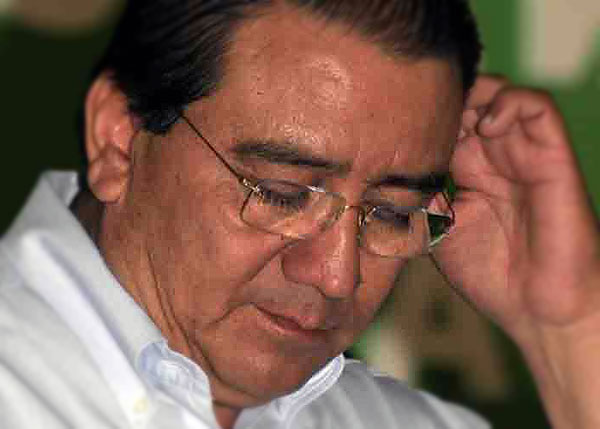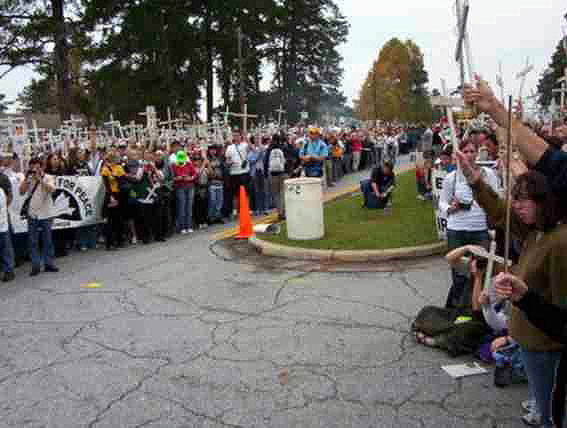SIPAZ Activities (July – September, 2004)
30/09/20042004
31/12/2004‘No Payment’ For Electricity And The ‘Better Life Tariff’
This December marks a year from the date that the state government of Chiapas signed an agreement with the Federal Electricity Commission (CFE), the body in charge of supplying the Mexican population with electricity. This agreement brought into being the program known as Tarifa Vida Mejor (TVM) – or “The Better Life Tarriff” – valid until 2006. According to the Governor of Chiapas, the objectives of the new plan are as follows: to put an end to the “culture of ‘not paying,’ to begin an era of ‘co-responsibility’ and (…) to reach a just electricity rate for all Chiapans.” Prisoners serving time for their role in the social struggle against unjust electricty costs were pardoned, and all legal actions being carried out against them were dropped.
The increase in electricity prices and the consequences derived from the refusal to pay represent one of the major problems in communities throughout the state of Chiapas. Various groups with whom we spoke during our recent visit to the Norte region (municipality of Tila) have protested along these lines. In the same vein, the Council of Good Government (JBG) of Roberto Barrios commented that the conflicts surrounding electricity and the CFE has been the main problem addressed during the council’s first year of work.
Overcharging for electricity is not unique to the municipalities in the Norte region, nor to the state of Chiapas. In the state of Tabasco, which borders on Tila, 52% of the population has not paid for electricity for the past 10 years, which represents one of the most important resistance movements in the nation. The movement was started by López Obrador (at the time a candidate for state government for the Democratic Revolutionary Party (PRD), and the current governor of Mexico City) to protest the electoral fraud that gave the Institutional Revolutionary Party (PRI) control of the state government (El Universal, 30 Oct. 2004).
But, we must remember that the municipality of Tila suffered the greatest level of violence carried out against the Zapatista uprising. In Tila, the group “Desarrollo, Paz y Justicia” – or “Development, Peace and Justice” – is accused of commiting paramilitary acts, which brought fear, displacements and death to community members who were not members of the group and were part of the Zapatista National Liberation Army (EZLN) or other organizations opposed to the PRI government, such as supporters of the PRD (known as “perredistas“) or members of ‘Abu Xu’ (a coalition of civil society organizations).
Currently, excessive charges for electricity are affecting all existing groups in the communities, although their responses to the problem differ depending on the organization. This problem sharpens social fractures existing since the conflict and is reason for worry among those of us familiar with the region.
In the communities in the Norte region, the houses have an average of three light bulbs per family; only a small percentage have electronic appliances, such as refrigerators or televisions; they only use light between 7 and 9 pm, since the rhythm of their lives coincides more with daylight hours. In many communities, electricity only arrived recently, including in some like Jolnixtié where the use of this service during the most intense period of the conflict was available exclusively to supporters of the PRI (referred to as “priistas“).
At first, families were charged $15 or $20 (in Mexican pesos), but recently they have begun to reach $50, 80, 300 or 500 pesos per family without any corresponding increase in the consumption of electricity. These are families that do not even receive the monthly minimum wage (1200 Mexican pesos, or approximately $120 US) so for them it is impossible to pay such high bills, leading to debts of thousands of pesos.
In addition to the difficulty of paying for electricity, the arrival of CFE officials in communities in order to cut power lines as retaliation for their failure to pay generates violent reactions from an indignant population frustrated by being saddled with the burden of electricity costs disproportionate to the economic conditions of their lives.
In this context, the TVM was presented as a resolution to the conflict. The plan established a minimum bimonthly consumption rate (300 or 400 kw/hour depending on the region of the State). Of this, consumers would receive a 51% discount on the first 150 kw used and a 12% discount on the next 100 kw. The lack of adequate information led many consumers to believe that the new rate would not take into account previous debts owed, that is to say, as if starting from a clean slate. Instead, the signing of the agreement implied recognizing the ‘record of consumption,’ and therefore previously accumulated debts. To the surprise of many, the debts have become so high that although the government took responsibility for a percentage of the total owed, the debts represent an impossibly high sum of money for families with no liquid assets.
Currently, those who accepted the terms of TVM and cannot pay their bills are seeing their electricity cut off definitively. The program has not produced the desired results as the majority of people ‘in resistance’ have rejected it and have maintained the ‘no payment’ stand.
Different Forms Of Resistance To Unjust Electricity Rates
In the Norte region, there are many forms of resistance to the unjust electricity rates. For their part, Zapatista bases of support have not paid for electricity since 1994 as part of their resistance movement against all government taxes and costs. In this instance, not paying for electricity is used as a tool to exert pressure on the government to honor the Peace Accords signed by the federal government and the EZLN on February 16, 1996. The Zapatistas claim electricity is the collective property of the nation, and therefore, demand that its distribution be public. The Councils of Good Government are taking over control of transformers to make up for the lack of CFE service in their territories.
Another form of resistance is known as the ‘civil resistance movement,’ created specifically by an organization in resistance to paying for electricity. In the municipality of Tila, the majority of civil society organized against the government during the conflict, and was thus displaced by the violent presence of the ‘Paz y Justicia’ paramilitary group. Their resistance began when they returned to their houses, after having narrowly escaped with their lives, and encountered bills with all of the debt accumulated during the time they had been displaced. The impossibility of paying such high bills, and indignation at being in debt to the CFE after having been forcibly displaced from their land, led to community members resisting against the CFE and later joining together as the civil resistance movement. Members of the movement refuse to pay while there are unjust rates. The organization Alianza Estatal de Resistencia Civil del Estado de Chiapas – or the “Civil Resistance Alliance of the State of Chiapas” – was formed in April of this year to lead the movement with the goal of fighting for a just electricity rate that is “consistent with the economic reality” of the population. The organization sees TVM as a trick to get people to pay their debts without establishing a truly fair rate.
Although supporters of the PRI are traditionally closely tied to the government, receiving government contracts or support, some “priistas” (many of whom originally accepted ‘TVM’) have stopped paying for electricity in the face of impossibly high bills.
There are also exceptions like the Autonomous Municipality of San Juan de la Libertad, where different political groups (supporters of the PRI, the PRD, and the Worker’s Party (PT), as well as Zapatistas) have organized to take over and repair the local transformer and maintain service for all community members.
Why Pay So Much For Such A Basic Natural Resource?: Privatization
Electricity is part of a set of fundamental economic, social and cultural rights that are necessary to ensure a dignified life. Electric energy in Mexico has been considered a public service since the administration of Lázaro Cárdenas, who had nationalized the Electricity Industry entirely by 1960. The CFE was created as a decentralized body in the late 1940s to provide electricity to the entire Mexican population, with the exception of private companies. Considered property of the Mexican populace, the CFE was supposed to be a public good.
The national energy policy was altered in 1992 when Article 27 of the Constitution was reformed, which opened the door to private investment in the nation.
According to the Center for Research on Economic, Political and Community Action (CIEPAC), Chiapas generates between 45% and 65% of Mexico’s hydroelectric energy. The contradictions become even more extreme when one notes that most energy produced in Chiapas is destined for Mexico City and its surrounding suburbs while, according to the Council of Good Government of La Realidad, 90% of the communities in its jungle region lack electricity.
Despite these social and economic inequalities, federal policies do not respond to local necessities but rather to the interests that come from “development” and consumerism in more industrialized countries. The high rates of consumption of energy in the United States and the lack of energy producing resources within the US explains its interest in free trade zones throughout the Americas, within which regional energy markets are created that can cover the needs of the US during the coming decades. CIEPAC believes that the resistance to paying for electricity may serve as an obstacle to the implementation to the Plan Puebla-Panamá (PPP), which would establish the Central American Electricity Interconnection System (SIEPAC). By 2007, they are hoping to establish a high capacity pipeline/trade corridor that will connect the region from Panama to Mexico and from Mexico to the United States. According to the Inter-American Development Bank (BID), the aim is to create ‘a Mesoamerican corridor that will encourage the private sector to participate in the development of the electricity market in the region’ in order to improve ‘the economic efficiency of the entire process of supplying electricity.’ (LaJornada, “Los frentes del PPP”/”The frontlines of the PPP,” 18 October 2004).
The United States National Energy Policy Development group released a report stating that: “The increased production of energy and cooperation between the United States, Canada and Mexico would bring us more security in terms of energy and, through our economic ties laid out in NAFTA (The North American Free Trade Agreement), would fundamentally improve the economic security of each nation.” Furthermore, the report indicated that the constitutional reforms of 1992 mean that private corporations may generate electricity for their own use and sell the excess to the CFE.
In the context of regional ‘free markets,‘ the Secretary of Treasury of the federal government released a decree to modify energy rates, eliminating some government subsidies (published in the Official Journal, on February 7, 2002). The measure was designed to funnel more government subsidies to users with the lowest levels of consumption and, at the same time, to collect more resources so that the public supply could be of the highest quality. However, the measure has not produced both of these projected results because the consumers who use the least amount of energy are those who are suffering the most from the modified rates; from community testimonies it becomes clear that the CFE has continued to be characterized by its unwillingness to provide maintenance and fair deals for communities. Months later, in August 2002, the federal executive presented a proposal to reform article 27 to allow the private sector to generate energy, a power historically reserved solely for the nation, and only maintaining federal control over the public administration of energy.
In April 2003, the National Supreme Court of Justice (SCJN) provisionally suspended the above decree. This decision opened the door to intervention through protective measures against the practice of overcharging, signaling that the subsidized rates should be reinstated and the difference returned to consumers.
There was a push to implement the protective measures in Chiapas, but they were never put into place due to corruption on the part of the lawyer in charge of processing them.
Civil Disobedience: A Path Of Resistance
We have been able to verify that the ‘TVM‘ is an aggregating factor in areas such as Tila where the social fabric is already damaged by war. Government institutions have exerted direct and indirect pressure on the population to accept TVM, insisting on its advantages and the convenience of complying with the plan. CFE officials have forced communities to sign on, threatening them by saying they would not repair transformers if the community didn’t sign. In some communities, even the designated ‘commissary‘ (community authority) has pressured families to sign the agreement, and in others, community members have been forced to sign in order to receive government contracts or support.
On top of this all, the quality of energy supply has not improved: blackouts occur daily in communities. There are also constant brownouts and spikes in voltage that damage electronic appliances. Consumption is not measured or checked directly in communities, which is reflected in the cynicism among consumers when neighbors compare bills and see that families with more electronic appliances are paying less, or that some do not even receive bills.
The organized resistance is trying to defend the people from these repressive actions, but the most vulnerable in these cases are those who do not have the backing of a group such as the EZLN or the civil resistance movement, and are having their electricity cut off permanently as has happened in some neighborhoods in the municipality of Yajalón. The leaders of the civil resistance movement have been victims of ‘selective’ power cuts, but thanks to their organization have been able to exert enough pressure to get their service reinstated.
Organized civil disobedience has become a survival response by society to unjust laws or decisions made by the authorities. In this case, it is being carried out against a rate policy and overall against a policy surrounding public services that has forgotten their social function. This route seems to be the only option when the rest of the paths are made impossible by lengthy and costly legal process and the lack of credibility of state institutions.
The resistance movement sees the privatization of the energy sector as the main reason behind increased electricity rates: “by charging high rates, the government is seeking to show foreign investors that the CFE is a business ripe for the picking” (Document produced by the Regional Coordinators of Civil Society in Resistance in Chiapas). The other dominant opinion posits that a general refusal to pay for electricity would be a perfect excuse to argue for the insolvency of the CFE and therefore the need to introduce private capital.
In this context, signing on to the ‘TVM‘ plan, beyond being controversial, represents a partial and limited proposal to not influence energy policy, which is decided in international political spaces, far from the reality of communities and where the voice of civil society was not included in the negotiations.
These resistances are part of the opposition of civil society to the privatization of electric energy. They shed light on the reasons that the Zapatista uprising coincided with the signing of NAFTA, and they indicate the importance of that struggle within the larger global movement against the privatization of basic resources such as electricity, oil, water, and biodiversity. These experiences are important steps in the restoration of autonomy, on the path towards bringing to life the vision of a world in which the people decide the policies that affect their daily lives.
Civil Disobedience: A Path Of Resistance



